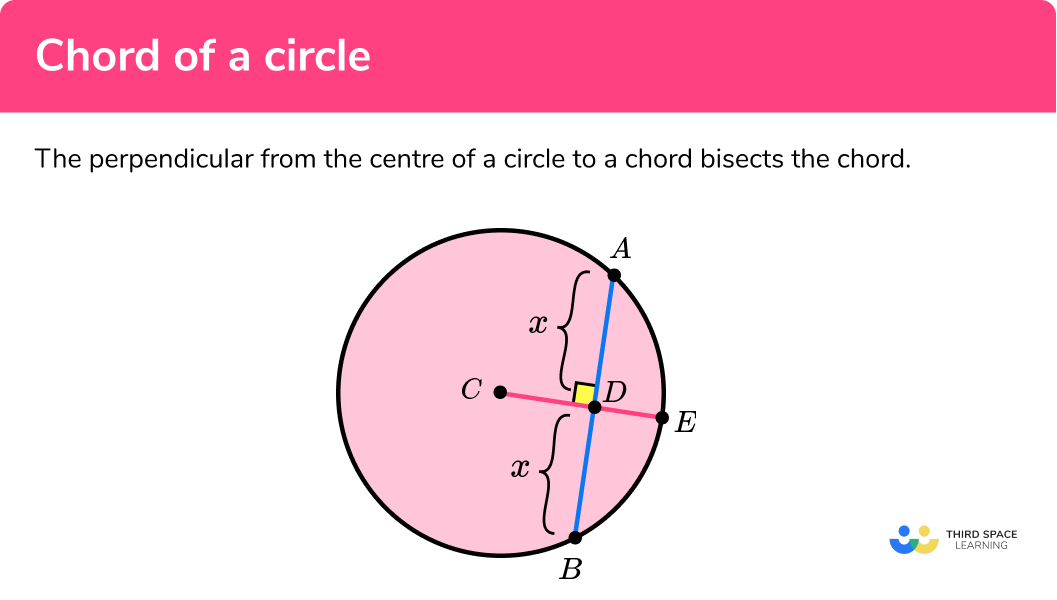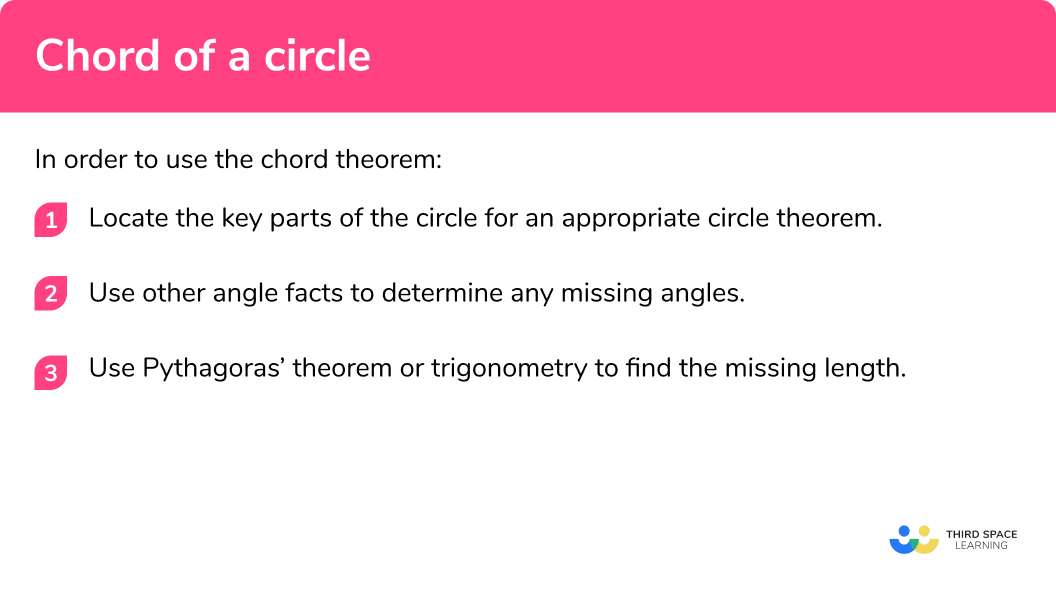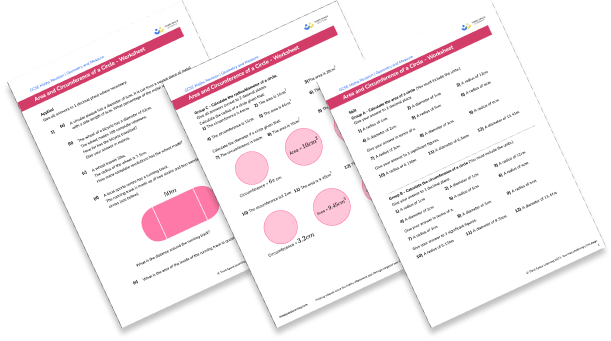One to one maths interventions built for KS4 success
Weekly online one to one GCSE maths revision lessons now available
In order to access this I need to be confident with:
Parts of a circle Angle rules Circle theorems Triangles Pythagoras theorem TrigonometryThis topic is relevant for:

Chord Of A Circle
Here we will learn about circle theorems involving chords of a circle, including its application, proof, and using it to solve more difficult problems.
There are also circle theorem worksheets based on Edexcel, AQA and OCR exam questions, along with further guidance on where to go next if you’re still stuck.
What is the chord of a circle?
The chord of a circle is a straight line that connects two points on the circumference of a circle. The longest chord in a circle is the diameter of the circle.
The perpendicular from the centre of a circle to a chord bisects the chord (splits the chord into two equal parts).
In the diagram above, AB is a chord and CE is a radius. Here we can see that the radius CE bisects the chord AB at 90 degrees and the lengths AD = BD = x .
What is the chord of a circle?

Key parts of a circle
Below is a diagram showing the key parts of a circle for this theorem:
- The diameter of the circle is the width of a circle, through the centre. The endpoints of the diameter lie on the circumference of the circle. The diameter is twice the length of the radius of the circle.
- An arc is a part of the circumference.
- The major segment is the larger part of a circle when it is enclosed by a chord and the major arc.
- The minor segment is the smaller part of a circle when it is cut by a chord and the minor arc.
- The radius of a circle is the distance between the centre of the circle and the circumference of the circle.
Subtended angles
An angle within a circle is created by two chords meeting at a point on the circumference. The diagrams below show the inscribed angle subtended by arc AC from point B for two different circles.
Top tip: The word subtend is used a lot within circle theorems so make sure you know what it means.
Proving that the perpendicular bisector from the centre of a circle to a chord bisects the chord
To be able to prove this theorem, you do not need to know any other circle theorem. You just need to be confident with angles in a triangle and congruence.
| Step | Diagrams | Description |
| 1 | Let’s start with the circle with centre C. The line AB is a chord and CE is a radius. The lines CE and AB intersect at the point D at 90 degrees to one another because they are perpendicular. | |
| 2 | We then draw the lines AC and BC. The length AC = BC as they are both radii of the circle. Triangles ACD and BCD are therefore both right angles, their hypotenuse are equal and the line CD is the same as it is shared between both triangles. This means that the triangles are congruent and so the line segment BD and the line segment AD are the same length or BD = AD. |
How to find missing lengths using chords
In order to find missing angles or the length of a chord:
- Locate the key parts of the circle for an appropriate circle theorem.
- Use other angle facts to determine any missing angles.
- Use Pythagoras’ Theorem or Trigonometry to find the missing length.
How to find missing lengths using chords


Chord of a circle worksheet

Get your free Chord of a circle worksheet of 20+ questions and answers. Includes reasoning and applied questions.
DOWNLOAD FREE
Chord of a circle worksheet

Get your free Chord of a circle worksheet of 20+ questions and answers. Includes reasoning and applied questions.
DOWNLOAD FREERelated circle theorems
Tangent of a circle is one of 7 circle theorems you will need to know. You may find it helpful to start with our main circle theorems page and then look in detail at the rest.
Chord of a circle examples
Example 1: cosine ratio
Below is a circle with centre C . Points A, B, C, and D are on the circumference of the circle. The chord AB is perpendicular to the line CD at the point E . The line AE is 5cm and angle ADE = 71° . Calculate the length of the line BC correct to 1 decimal place.
- Locate the key parts of the circle for an appropriate circle theorem.
Here we have:
- CD is a diameter
- AB is a chord, perpendicular to CD
- The angle ADE = 71°
- The angle BEC = 90°
- The line AE = 5cm
- The line BC = x
2Use other angle facts to determine other necessary angles.
As angles in the same segment are equal, angle ADE is equal to angle ABC so angle ABC = 71° . Also, as the perpendicular from the centre of a circle to a chord bisects the chord, the line BE is equal to AE , so BE = 5cm .
3Use Pythagoras’ theorem or trigonometry to find the missing length.
To calculate the length of the chord BC , we need to use trigonometry as we know one side length and two angles where one angle is 90° .
As we know the side adjacent to the angle and we want to calculate the hypotenuse, we need to use \cos(\theta)=\frac{A}{H} with H as the subject.
H=\frac{A}{\cos(\theta)}
x=\frac{5}{\cos(71)}
x=15.4cm (1dp)
Example 2: sine ratio
Below is a circle with centre O . A, B, C, and D lie on the circumference. AC and BD are perpendicular lines. Calculate the length of AE , correct to 1 decimal place.
Locate the key parts of the circle for an appropriate circle theorem.
Here we have:
- BD is a diameter
- AC is a chord, perpendicular to BD
- The angle CDE = 35°
- The angle CED = 90°
- The line CD = 8cm
- The line AE = x
Use other angle facts to determine other necessary angles.
As the perpendicular from the centre of a circle to a chord bisects the chord this means that the length AE is the same as the length CE .
Use Pythagoras’ theorem or trigonometry to find the missing length.
We can calculate the length of CE using the right angle triangle DEC as we know the hypotenuse, an angle and we are finding a missing side:
Example 3: tangent ratio
Below is a circle with centre O . A, B, C, and D lie on the circumference. AC and BD are perpendicular lines. FG is a tangent at the point B and is parallel to the line AC . Calculate the length of BE , correct to 1 decimal place.
Locate the key parts of the circle for an appropriate circle theorem.
Here we have:
- BD is a diameter
- AC is a chord, perpendicular to BD
- The angle ABF = 77°
- The line CE = 12cm
- The line BE = x
Use other angle facts to determine other necessary angles.
As the perpendicular from the centre of a circle to a chord bisects the chord this means that the length AE is the same as the length CE .
As the tangent and the radius meet at 90° , the angle EBF = 90° . This means that we can calculate the angle ABE :
Use Pythagoras’ theorem or trigonometry to find the missing length.
We can calculate the length of the chord BE using the right angle triangle ABE as we know the opposite side to the angle ABE , the angle ABE and we are finding a missing adjacent side BE :
BE=\frac{O}{\tan(\theta)}
x=\frac{12}{\tan(13)}
x=52.0cm (1dp)
Example 4: Pythagoras theorem
A, B, C, and D are points on the circle with centre O . The radius OA = 6cm and the chord AB = 13cm . The chord BD is perpendicular to the diameter AC at E .
OE:OC = 1:1 . Calculate the length of BE marked x .
Locate the key parts of the circle for an appropriate circle theorem.
Here we have:
- AC is a diameter
- BD is a chord, perpendicular to AC
- The line AB = 13cm
- The line OA = 6cm
- The line BE = x
Use other angle facts to determine other necessary angles.
AEB is equal to 90° as the chord is perpendicular to the diameter. As OE:OC = 1:1 , the line segments OE and OC are equidistant so OE is half of the radius and so OE = 3cm . This means that AE = 6 + 3 = 9cm . We now have
Use Pythagoras’ theorem or trigonometry to find the missing length.
We have a right angle triangle ABE and as the missing length can be found using the other two sides of the triangle, we will use Pythagoras’ Theorem:
Example 5: isosceles triangle
A circle with centre O has the perpendicular diameters AC and BD . Use the information in the diagram to calculate the value of x .
Locate the key parts of the circle for an appropriate circle theorem.
Here we have:
- AC = BD is a diameter
- AC and BD are perpendicular
- The line OC = 4cm
- The line AB = x
Use other angle facts to determine other necessary angles.
OA = OB = OC = OD are all radii and so we can state OA = OB = 4cm . AOB is equal to 90° as AC and BD are perpendicular.
Use Pythagoras’ theorem or trigonometry to find the missing length.
As we know two sides of the right angle triangle AOB , we need to use Pythagoras’ Theorem to find the value of x (the length of the chord AB ).
Example 6: semicircle
The diagram below shows a semicircle. The line BF is a chord that is perpendicular to the diameter. Calculate the length of the diameter AD .
Locate the key parts of the circle for an appropriate circle theorem.
Here we have:
- AD is a diameter
- BF is a chord, perpendicular to AD
- The angle BGE = 112°
- The line DE = 3cm
- The line AD = x
Use other angle facts to determine other necessary angles.
The angle in a semicircle is equal to 90° so angle AEB = 90° . Angles on a straight line total 180° , so BGA = 180 - 112 = 68° . As angle ABG = 90° , angle BAG = 180 - (90 + 68) = 22° . We now know
Use Pythagoras theorem or trigonometry to find the missing length.
As ADE is a right angle triangle with DE = 3cm and DAE = 22° , we can use trigonometry to calculate the side AD :
Common misconceptions
- Pythagoras’ theorem missing side
The missing side is calculated by incorrectly adding the square of the hypotenuse and a shorter side, or subtracting the square of the shorter sides.
- Incorrect trigonometric function
The incorrect trigonometric function is used and so the side or angle being calculated is incorrect. This also includes the inverse trigonometric functions.
- Incorrect assumption of isosceles triangles
The intersection of the diameter and the chord at 90 degrees can be very close to the centre and so the two lengths coming from the point of intersection to the radius are assumed to be equal, but they aren’t.
Practice chord of a circle questions
1. A, B, C and D are points on a circle with centre O . BD is the diameter and AC is a chord that is perpendicular to the diameter at E . BE = 2cm and CDE = 30^{\circ} . Calculate the length of x , the distance between C and E .




- AE = x
- BAE = 30^{\circ} (angles in the same segment are equal)
- x=\frac{2}{\tan(30)}=2\sqrt{3}
2. Below is a circle with centre O . AC is a chord, perpendicular to the diameter BD . Use the information in the diagram to calculate the value of x .




- AEB = 90^{\circ} ( AC is perpendicular to BD )
- BAE = 40^{\circ} (angle in a semicircle is 90^{\circ} so BAD=90^{\circ} )
- ABD = 50^{\circ} (angles in a triangle total 180^{\circ} )
- x=\frac{10}{\tan(50)}=8.39\quad(2dp)
3. The circle with centre O has a tangent EF at the point C . The chord BD is parallel to the tangent, intersecting the diameter AC at G . The angle BCF = 51^{\circ} and CG = 3cm . Calculate the length of CD .




- CBG = 51^{\circ} (alternate angles in parallel lines are equal)
- BC = CD = x ( BCD is an isosceles triangle)
- x=\frac{3}{\sin(51)}=3.86\quad(2dp)
4. The line AC is a diameter through the centre of the circle O . BD is perpendicular to AC at E . The radius OA = 10cm and DE = 7cm .
OE=\frac{3}{5}OC . Calculate the length of AB .




- BEA = 90^{\circ} ( AC is perpendicular to BD )
- BE = DE = 7cm ( BD is bisected by the diameter)
- OE=\frac{3}{5}\times{10}=6
- AE = 10 + 6 = 16cm
- x=\sqrt{7^{2}+16^{2}}
- x=17.46cm (2dp)
5. The points A, B, C, and D lie on the circumference of the circle with centre O . The length of BC = 6cm and AC and BD are perpendicular to one another. Calculate the length of OD .




- OC = OD = x
- BOC = 90^{\circ} ( AC and BD are perpendicular)
where M is the midpoint of BC .- x=\frac{3}{\sin(45)}=3\sqrt{2}
6. The semicircle has a diameter AD . The chord BF is perpendicular to the diameter at B . BGE = 99^{\circ} and AG = 9cm . AC:CB = 8:3 . Calculate the radius of the semicircle.




- ABF = 90^{\circ} ( BF is perpendicular to AD)</li> <li> BGA = 180 - 99 = 81^{\circ} (angles on a straight line total 180^{\circ} )
- AB = 9sin(81)=8.89cm (2dp)
- AC=\frac{8}{11}AB
- AC = 6.46cm (2dp)
Chord of a circle GCSE questions
1. Below is a triangle inscribed in a circle with centre O . The line BC is parallel to the tangent DE . BG = 6.2cm . Calculate the length of the line AB .
(3 marks)
ABC = 55^{\circ} (alternate segment theorem)
(1)
AGB = 90^{\circ} ( BC is perpendicular to AF )
(1)
x=\frac{6.2}{\cos(55)}=10.8cm\quad(1dp)(1)
2. (a) The circle below has centre O. The diameter BD is perpendicular to the chord AC at point E. CE = 5.4cm and angle AB = 8.1cm. Calculate the length of the line BE.
(b) Calculate the size of the angle ABE. Write your answer to 1 decimal place.
(5 marks)
(a)
AE = CE = 5.4cm
(1)
BE=\sqrt{8.1^{2}-5.4^{2}}(1)
BE = 6.04cm (2dp)(1)
(b)
ABE=\sin^{-1}(\frac{5.4}{8.1})
(1)
ABE = 41.8^{\circ} (1dp)(1)
3. The diagram below shows a circle with the following information:
- Centre O
- AC is a straight line through B
- AD = CD
- DH = 3cm
- BH = 8cm
Calculate the length of BC , labelled x .
(5 marks)
CDA = 90^{\circ} as the tangent meets the radius at 90^{\circ} and AHB = 90^{\circ} as BF is parallel to CE
(1)
AH = BH = 8cm
AB=\sqrt{8^{2}+8^{2}}=8\sqrt{2}
(1)
AD = CD = 11cm
Scale factor of enlargement: 11\div8=1.375
(1)
AC=8\sqrt{2}\times{1.375}=11\sqrt{2}(1)
11\sqrt{2}-8\sqrt{2}=3\sqrt{2}cm(1)
Learning checklist
You have now learned how to:
- Apply and prove the standard circle theorems concerning angles, radii, tangents and chords, and use them to prove related results
The next lessons are
Still stuck?
Prepare your KS4 students for maths GCSEs success with Third Space Learning. Weekly online one to one GCSE maths revision lessons delivered by expert maths tutors.

Find out more about our GCSE maths tuition programme.